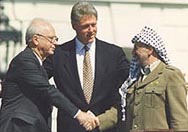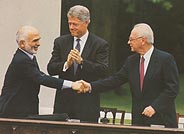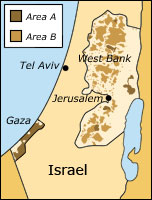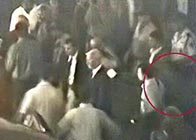|
Untitled Document
|
The
History
of Israel
- A Chronological Presentation

4.
Peace With The Arabs? (1993 - 1996)
1993
- The Oslo Process
Behind the scenes the Israeli leadership was informed,
via a Norwegian mediator, that the PLO, which since
the Gulf War had been internationally marginalized,
and whose influence also was declining in the Palestinian
territories, had expressed willingness to negotiate
with Israel. Secret meetings between Israeli representatives
and PLO members began in Oslo in January 1993. Significant
progress was made, and in August that year a "Declaration
of Principles" began to take shape.
The document described the principles
for a 5-year transitional period with Palestinian self-government,
starting with Gaza and Jericho, aiming to eventually
include all major Palestinian population centres on
the West Bank. After the transitional period the parties
were to negotiate a final status agreement. The questions
of final borders, the future status of Jerusalem and
the Palestinian refugee problem were deferred to a later
phase.
 |
 |
Israeli
prime minister Yitzhak Rabin
shakes PLO leader Yasser Arafat's
hand at the White House, 1993.
|
In order to achieve the PLO's approval of the document,
the Israeli prime minister, Yitzhak Rabin, offered to
recognize the PLO, under Yasser Arafat's leadership,
as the rightful representative of the Palestinian people.
Arafat accepted the gesture and reciprocated by recognizing
Israel's right to exist in peace and security, and
declared that the PLO would give up the use of terrorism
and violence. On september 13, 1993 Arafat and Rabin,
at a ceremony hosted by the American president, Bill
Clinton, shook hands on the "Declaration of Principles
on Interim Self-Government," also known as the
Oslo Agreement, outlining the guidelines for the coming
peace process.
1994 - Establishment
of the Palestinian Authority
The implementation of the agreement on Palestinian self-government
went anything but smoothly. While Israel and the PLO
were negotiating the details of the arrangement, Palestinians
from Hamas, Islamic Jihad and Yasser Arafat's own Fatah
organization were trying to derail the process. During
the autumn of 1993 fifteen terror attacks cost the lives
of 19 Israelis.
In February 1994 a member of the radical, Jewish organization,
Kach, gunned down 29 Arabs at the "Tomb of the Patriarchs"
in Hebron. Over a hundred were wounded, before the assailant
himself was overpowered and killed.
 |
 |
|
Most of Gaza and an area
around the town of Jericho are
transferred to Palestinian
control, May 1994. |
The Israeli government condemned the massacre, offered
financial compensation to the families of the victims,
and declared the Kach movement a terrorist organization.
Israel and the PLO subsequently agreed on the stationing
of interna-tional observers in Hebron, the only town
in the West Bank that houses both Jews and Arabs.
In the months of March and April Hamas directed a
series of terror attacks against Israeli busses and
similar targets, claiming a total of 17 Israeli lives.
Despite the setbacks the negotiations between Israel
and the PLO continued, and on May 4, 1994 the parties
signed an agreement detailing the conditions for the
establishment of a "Palestinian Authority,"
and the implementation of the first phase of the peace
proccess, called "Gaza and Jericho First."
Israel pulled its troops out of the agreed areas,
which were transferred to Palestinian control. Shortly
after, Arafat arrived at Gaza Airport as chairman
of the Palestinian Authority.
1994 - Peace with
Jordan
Since Jordan had already relinquished all claims
to the West Bank, it was in reality only pressure from
other Arab states that had prevented it from making a
separate peace with
 |
 |
King
Hussein, Clinton and Rabin at
the presentation of the peace treaty
between Israel and Jordan, 1994. |
Israel. So when the general atmosphere in the region allowed,
the two countries seized the opportunity to negotiate
a peace treaty, which only involved marginal territorial
adjustments. The deal was concluded on July 25, 1994,
and signed at an official ceremony on October 26, 1994.
Jordan thus became the second Arab country to make peace
with Israel.
1995 - The Oslo II Agreement
During the summer of 1994 the Palestinian terror intensified,
and the follwing year almost 100 Israelis (mainly civilians)
were killed in suicide bombings and other attacks. The
 |
 |
|
Area A: territory under Pale-
stinian control, Area B: terri-
tory under joint Palestinian-
Israeli control. |
Islamist organizations, Hamas and Islamic Jihad were responsible
for the majority of the attacks.
Despite the Palestinian Authority's poor performance
on preventing terror, Israel and the PLO on September
28, 1995 signed the so-called "Oslo II Agreement,"
outlining further Israeli withdrawals from the West
Bank. In return the agreement, like its predecessor,
contained a series of demands to be met by the Palestinian
Authority. It soon became clear, however, that the
Palestinian Authority was still not honoring its side
of the agreement. Nevertheless Israel did - with some
delays - carry out the projected withdrawals.
 |
 |
The
moment when
Rabin is shot,
November 4, 1995 (from Israeli TV). |
1995 - The Murder
of Rabin
In yet another assault on the peace process the Israeli
prime minister, Yitzhak Rabin, was murdered by a right-wing
radical Orthodox Jew during a peace rally in Tel Aviv.
The assassin was caught and later sentenced to life
inprisonment. Deputy prime minister Shimon Peres took
over the post as prime minister. The peace pro-cess
continued, and in the following three months Israeli
forces were withdrawn from most of the larger Palestinian
cities.
At the May 1996 Israeli general election Shimon Peres
and the Labor Party sought a renewed mandate to continue
the peace process with Yasser Arafat and the Palestinian
Authority. But a fresh wave of suicide attacks committed
by Hamas, in which 57 Israelis were killed in a single
week in March-April 1996, sent tremors through the Israeli
public, and Benjamin Netanyahu from the right-wing Likud
Party, who were opposed to the negotiations with the
PLO, won the election.
Continue:
Chapter 4 - Peace With The Arabs? - Page 3
Back
|
Untitled Document
|